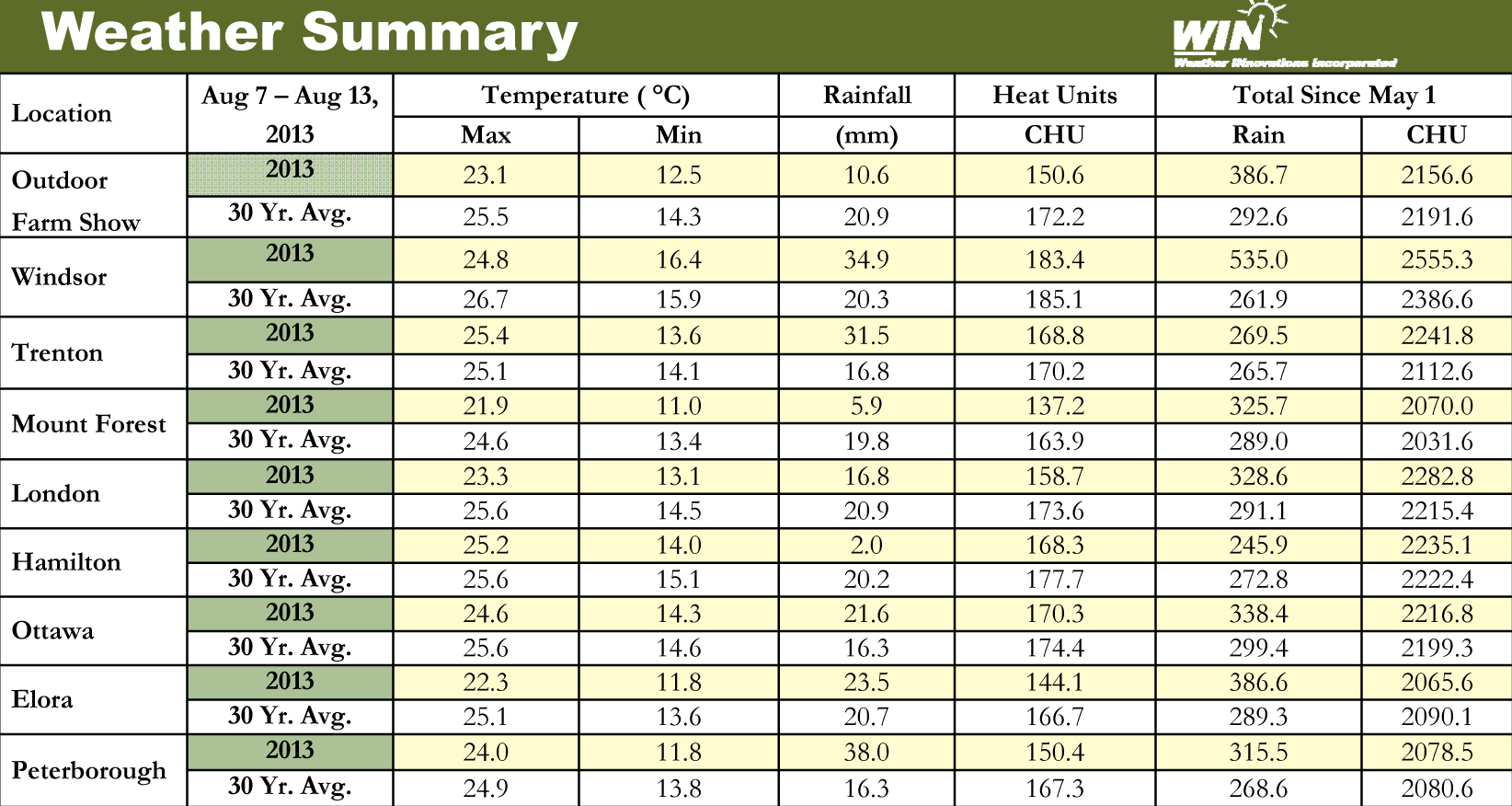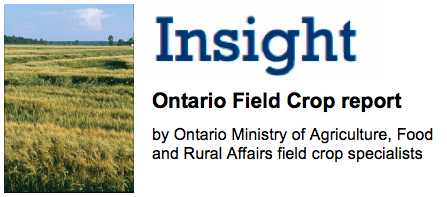Corn: Greg Stewart
Although most areas are very close to normal CHU accumulation, recent cool evening temperatures and cloudy conditions have slowed crop development significantly. Normal development for mid- August should be milk stage but a lot of the crop is in the late pollination to blister stage. Detecting successful pollination without waiting for the kernel blisters to appear can be done by carefully removing the husks, turning the ear upside down and gently tapping it. The majority of silks should fall off indicating successful pollination. Silks that remain attached indicate kernels that have not been pollinated and will tend to be ones attached at the outer end of the ear. Many fields are also showing premature signs of N stress most likely caused by denitrification and/ or leaching in areas with abnormally high rainfall. Forty percent of the total plant N is taken up after silking. In some cases high clearance applications of additional N may still be attempted on fields where yield potential is good and obvious N deficiency appears significant. Fields where manure or red clover credits were calculated as strong contributors to N availability are commonly showing N deficiency due to apparent lower mineralization this season.
Cereals: Peter Johnson
Harvest progress has been extremely slow due to the frequent showers. Yields and quality have been excellent in the northern regions, with many reports of 100+ bu/ac, grade 1 and no (low) Fusarium. Sprouts and mildew are now being found, but generally at low levels with limited impact. Toxin levels continue to be of concern, with reports of Grade 3 wheat testing well over 2 ppm in some cases. Overall, there is sufficient quality wheat, but Fusarium hotspots will struggle with grades and marketing this year’s crop all season. Spring cereal harvest is underway. Barley yields range widely, with very high levels of Fusarium in some barley fields. Barley growers need to seriously consider trying winter barley: yields are much higher, straw yields and quality are equal, and Fusarium often lower as winter barley is more likely to avoid infection due to lower temperatures at the early heading dates of the fall seeded crop. Spring wheat harvest is just underway. Fusarium fungicides are proving just as valuable in spring wheat as they did in winter wheat. Unsprayed plots have high Fusarium counts and poor quality kernels due to reduced grain fill. Sprayed fields have both higher yields and better samples. Most unsprayed oat fields are suffering as well, with low yields and extremely low test weights. Seeding of oats as a cover crop is in high gear. Do not forget that nitrogen is a key component of successful oat (barley, tillage radish, annual ryegrass) growth as a cover crop. Apply 56 kg/ha (50 lbs/ac) of nitrogen, either as manure or applied fertilizer, is recommended to achieve optimal growth.
Edible Beans and Canola: Brian Hall
Edible Beans: Early cranberry fields are maturing rapidly and harvest is expected to begin within 10 days. Stress to the dry bean crop from excess rainfall, root rot, and poor soil structure has caused reduced pod set and more pod abortion in some areas. Potash deficiency is evident in dry regions. Foliar applications are not effective. Scout later maturing fields of white and black bean fields for anthracnose. Pod and seed damage from tarnished plant bugs (TPB) is evident in areas. TPB often migrate into beans from nearby orchards or recently harvested alfalfa. The control threshold is one or more bugs per plant between flowering and green pod stage. The unevenness of maturity in many fields along with a late season flush of weeds will make it more challenging to hitt the timing of pre-harvest desiccant applications. Pre-harvest herbicide will not speed up crop maturity, but helps dry down the crop and weeds more evenly, allowing timely harvest and reduced field losses. A pre-harvest treatment can help maintain bean quality by reducing staining. Check your contract or with your dealer for approved pre-harvest products.
Spring Canola: Early spring canola is maturing quickly with harvest anticipated to begin within 10 days. Cool weather has been favourable for pod fill. This year’s canola crop could be a challenge to harvest as a result of tremendous unevenness in maturity, thin stands, or fields damaged by swede midge. To minimize pod shattering losses with direct harvest, do not delay harvest. Field losses from heavy rain, wind or hail can be high, particularly if the crop is not heavy and will knit together. Heavy pod feeding from flea beetles can increase pod shatter. Pre-harvest herbicides can be used to even out dry down of the crop, but be prepared to harvest when the crop is ready, otherwise the crop is exposed to shattering losses. In fields with adequate plant population but are uneven in maturity the typical time of swathing is 60% seed colour change on the main stem. If the crop is thin, then more yield will come from branches, so the time of swathing should be based on whole plant seed colour change rather than just the main stem. If swathing, note that green seed content cannot be lowered once canola is stored in the bin. Moisture from heavy dew or rainfall occurring post-swathing helps speed up the curing process.
For more tips on harvesting visit Ontario Canola Growers website.

| Attachment | Size |
|---|---|
| 665.41 KB |



